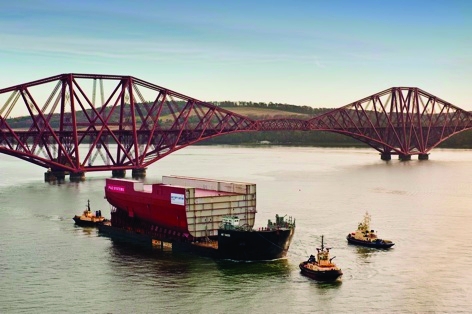The assembly cycle of the Aircraft Carrier HMS Queen Elizabeth continues in the dry dock at Rosyth. Since my last blog just about all the blocks comprising the forward end of the hull have been assembled, and consolidation, fairing and welding is progressing well. The only parts yet to be assembled are the upper parts of the bow including the mooring flat and the ramp; the forward end of the port gun sponson; and the upper sections of the starboard sponson. This latter area makes up the forward gas turbine room. The lower parts of the sponson are in place, the deck has been shot blasted and painted and the seats installed and machined ready for the installation of the Rolls Royce MT30 Gas Turbine Generator. Being used to more traditional warship designs it is quite strange to be preparing a machinery space high above the coping of the dock rather than down in the depths on the double bottom, one of the benefits of an Integrated Electric Propulsion system.

We have had a number of important visitors to Rosyth over the past few months to witness progress with the build of the giant aircraft carrier to gain a bird’s eye view of the ship from the control cab of the Goliath crane and to walk the decks of the ship itself. Most notable of the visitors have been the Princess Royal in September followed a week later by the Duke of Edinburgh. Both appeared fascinated by the build process and the scale of the ship. The Prince in particular put some of my colleagues to shame with the speed at which he negotiated the ladders between decks. In October the Prime Minister visited us and was photographed in front of the ship on a rare gloriously sunny day. We expect more visitors as the build progresses.
Lower Block 04, which was assembled at BAE Systems shipyard at Govan on the Clyde, is the largest single block of the whole aircraft carrier weighing more than 11,000 tonnes. When in the build hall at Govan, the block was so large that it stuck a considerable way through the door. This block makes up most of the after part of the ship up to hangar level and comprises the aft machinery spaces and all four propulsion motors. Load-out onto the transportation barge took place on 15 October: it required a huge number of Self Propelled Modular Trailers (SPMT) all linked together so that they move and manoeuvre the block as one controlled by a single controller with a joystick. The load out from the build hall across the quay wall and onto the semi-submersible transportation barge was carried out without a hitch and the sea fastenings attached so that the barge was ready to depart Govan on 29 October, almost a week earlier than the plan. Unfortunately, the weather has intervened, with forecasts of very strong winds off the north coast of Scotland, and the departure had to be postponed. It seemed a shame as on the 29th there was not a breath of wind at Govan, but clearly it is better for the barge to be moored up safely at Govan than trying to find shelter off the west coast in deteriorating weather. LB04 finally departed on 4th November travelling around the South of England instead of north; the 1200 mile journey took one week with the block arriving in Rosyth on Remembrance Sunday. LB04 will be floated off from the barge and then docked down in the build dock separated from the rest of the ship by the intermediate gate. Skidding of the forward part of the ship to align with LB04 is currently planned to occur between Christmas and New Year and will result in nearly the whole length of the carrier being visible.

While these large block movements are taking place bringing the ship to life continues. A significant event was the first running of two Air Treatment Units within Damage Control Zone 3, this signalled the start of setting to work the Heating Ventilation and Air Conditioning (HVAC) system designed and manufactured by Imtech. Design and integration of the huge HVAC system on these aircraft carriers has been a challenging programme and it is particularly satisfying to see the system start to come to life.
The Integrated Platform Management System (IPMS) software is now installed on board HMS Queen Elizabeth and is being used by the commissioning team to control the Low Voltage breakers in Damage Control Zone 3 (DCZ3), with the plan for them to shortly move onto DCZ2. This is a particularly significant evolution in bringing the ship to life and while challenges remain in getting the full IPMS fully functional this is an extremely good start.
On the South Coast a successful trial has been conducted using the Link 16 Communications system to communicate between the shore integration site and HMS Illustrious. This has proven the ability to communicate with an existing warship at sea and has significantly de-risked the integration on board the ship.
The second ship HMS Prince of Wales is also progressing well. The diesel generators have recently been loaded into Lower Block 02 of Prince of Wales at the BAE Systems yard at Portsmouth, an important milestone and one that incorporated many of the lessons learned from carrying out these evolutions on Queen Elizabeth.











Water Sector Talent Exodus Could Cripple The Sector
Maybe if things are essential for the running of a country and we want to pay a fair price we should be running these utilities on a not for profit...